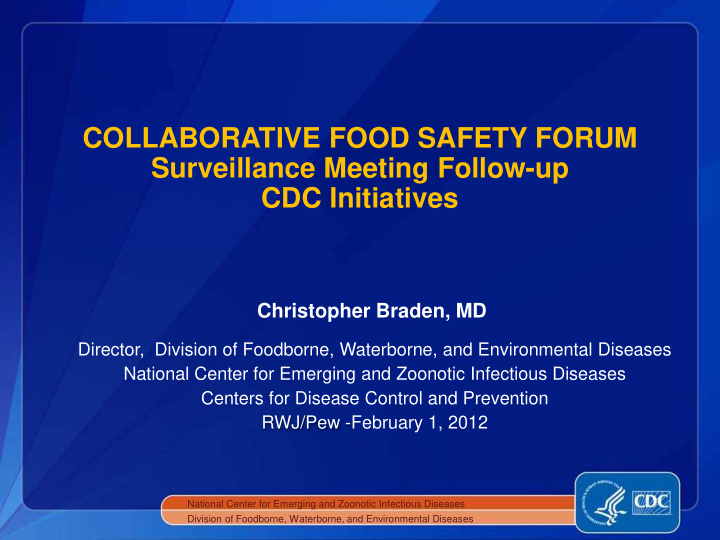



COLLABORATIVE FOOD SAFETY FORUM Surveillance Meeting Follow-up CDC Initiatives Christopher Braden, MD Director, Division of Foodborne, Waterborne, and Environmental Diseases National Center for Emerging and Zoonotic Infectious Diseases Centers for Disease Control and Prevention RWJ/Pew -February 1, 2012 National Center for Emerging and Zoonotic Infectious Diseases Division of Foodborne, Waterborne, and Environmental Diseases
How did Surveillance Meeting help CDC? Reinforced concept that foodborne illness surveillance systems: Are critically important as the basis for science based prevention policies Have a number of strengths, but can be improved Need new data sources to fill in gaps Are not just for outbreak detection and investigation • just one aspect of a comprehensive surveillance system that has multiple sources and uses One of those uses is for food source attribution ( covered in today’s forum).
Surveillance Workshop Follow-up Collaborative Food Safety Forum identified 4 specific areas for follow-up: Industry scoping Standardized interviews and data elements Better use of NARMS data, and Culture independent diagnostic technologies
CDC Follow-up and Initiatives Broader set of initiatives Engaging Industry Strengthening exposure information Integrating surveillance systems Addressing challenges of new diagnostic technologies Restoring and rebuilding lost state and local capacity
Engaging Industry Industry scoping meetings UGA-CDC Food Industry Safe Foods Forum CIFOR industry work group Enhanced communications Building relationships
Strengthening Exposure Information FoodCORE projects Standard data elements and questionnaire for outbreak investigations • Currently seeking OMB approval IT tools for use by federal, state and local investigators • Live, shared line list • Shared platform for secure data collection Core exposure data elements for routine interviews Listeria Initiative
Integrating Surveillance Systems Current projects to link records from multiple surveillance systems NARMS FoodNet Laboratory-based Enteric Diseases Surveillance (LEDS) PulseNet Foodborne Diseases Outbreak Surveillance System Platforms to view and display data from multiple sources Palantir PulseNet portal
Addressing Challenges of Culture-Independent Diagnostic Tests Monitoring uptake of CIDTs in clinical laboratories Assess test characteristics (sensitivity and specificity) Develop new case definitions for surveillance Explore ways to preserve culture-based testing CIDT meeting: “Charting a Path for Public Health” scheduled for April 25,26 in Atlanta Scientific manuscripts (to increase awareness) Applied research to promote development of new methods which meet public health needs
Restoring and Rebuilding Lost State and Local Capacity FoodCORE best practices CIFOR guidelines and implementation toolkit Epi Ready training Environmental assessment training tools PulseNet and OutbreakNet annual meetings
Recommend
More recommend